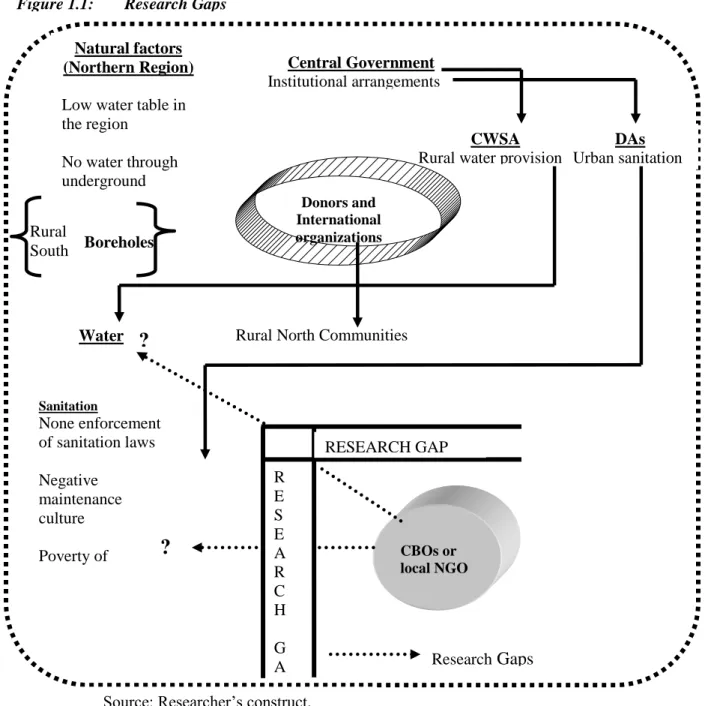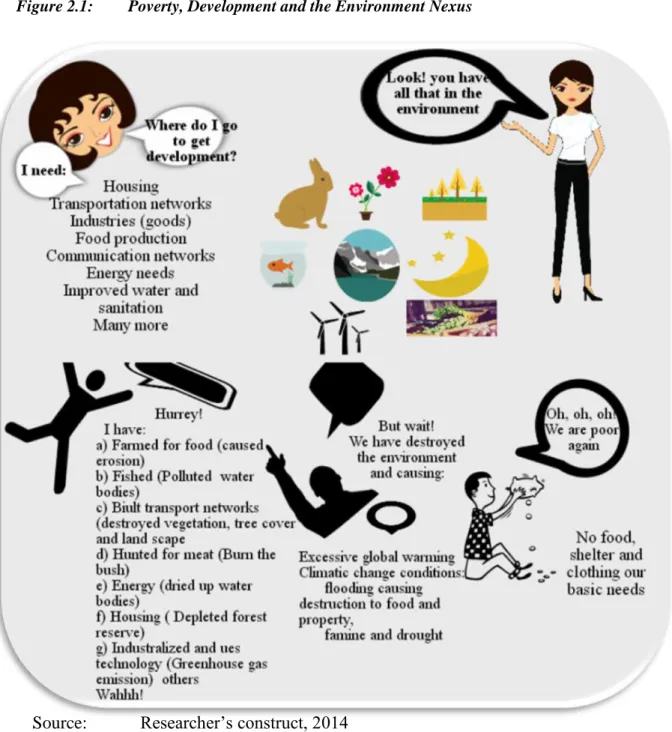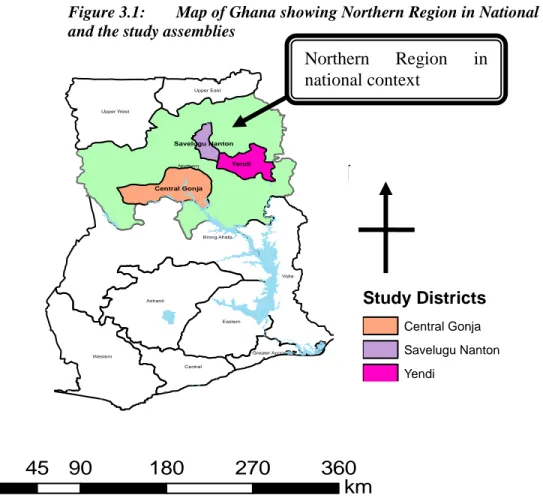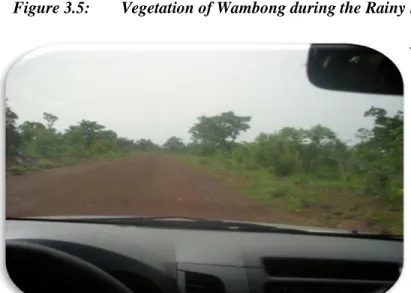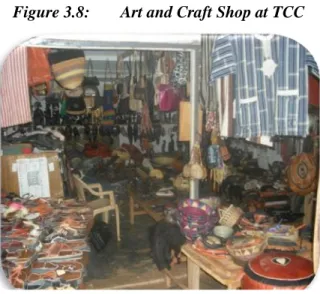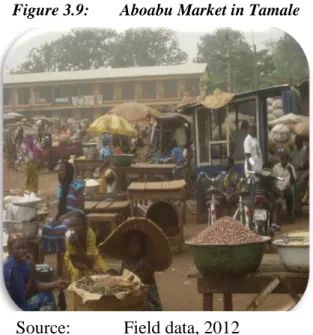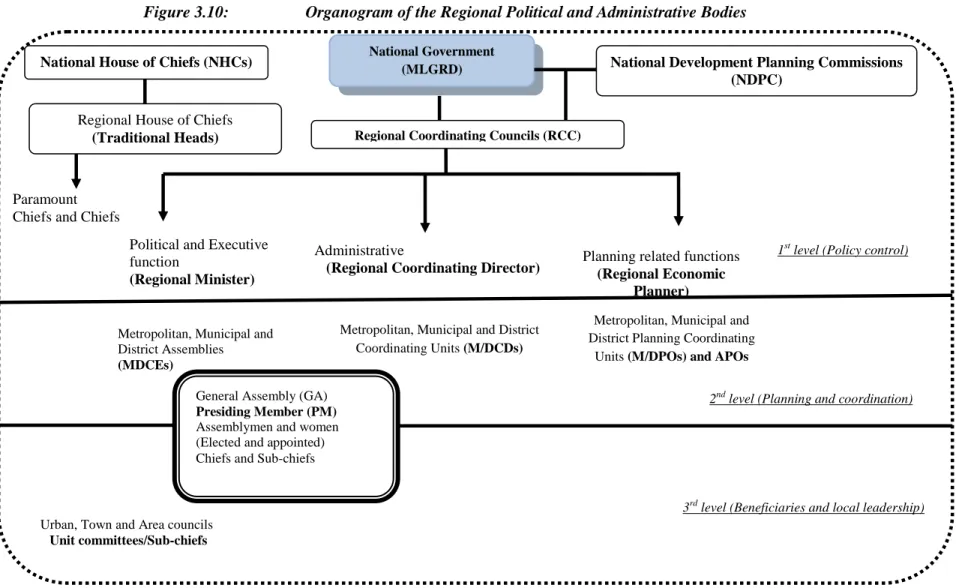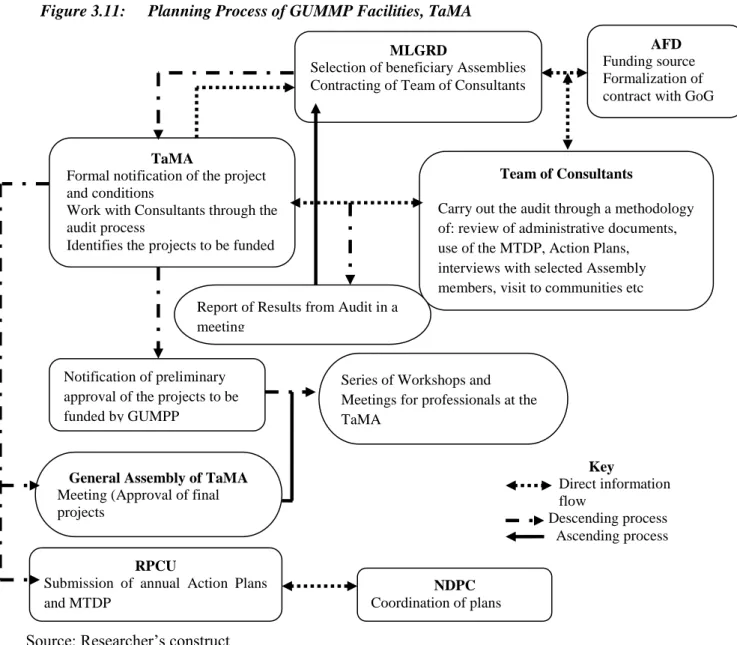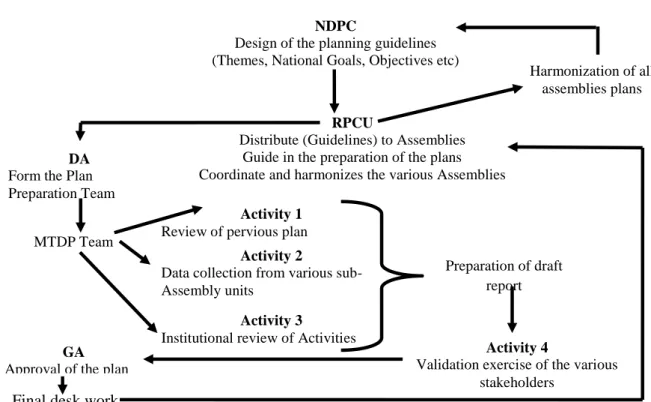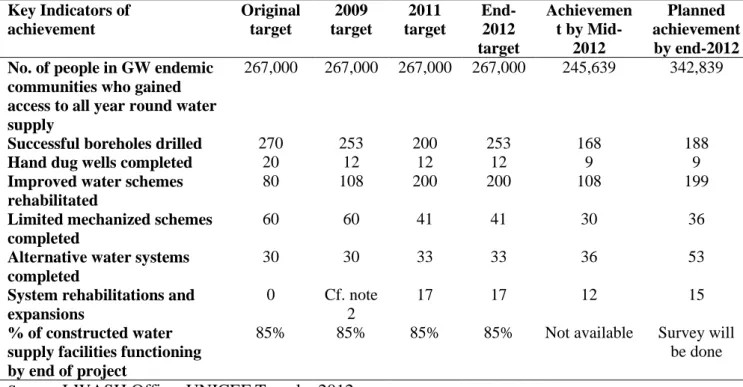i
WATER, SANITATION AND POVERTY: CBOS ACTIVITIES AND POLICY PLANNING IN NORTHERN REGION, GHANA.
By
Eva Azengapo Akanchalabey
Dissertation Committee:
Univ.-Prof. Dr. Einhard Schmidt-Kallert Univ.-Prof. Dr. Francis Z. L. Bacho Dr. Karin Gaesing
February, 2015
ii
Water, Sanitation and Poverty: CBOs Activities and Policy Planning in Northern Region, Ghana.
By
Eva Azengapo Akanchalabey
A thesis submitted to the PhD Board of the Faculty of Spatial Planning of the TU Dortmund University in partial fulfillment of the requirements for the Degree of Doctor rerum politicarum.
Dissertation Committee:
Univ.-Prof. Dr. Einhard Schmidt-Kallert Univ.-Prof. Dr. Francis Z. L. Bacho Dr. Karin Gaesing
Date of Disputation: January 15, 2015
Published: February, 2015
iii
With unflinching love and profound gratitude, appreciation, and gratefulness To my loving Mother, Son, and the entire Akanchalabey’s family for their support,
motivation, love and encouragement to me during this study
iv
Declaration
I,
Eva Azengapo Akanchalabey, hereby declare that thisacademic work (thesis) has been independently and originally written and produced by me in fulfillment of the requirement for a PhD degree.
Where information, data and/or other earlier material(s) has been derived from other sources, I confirm that this has been indicated clearly and concisely.
Dortmund, Germany ……….. ……….
Place and Date Name of Candidate: Eva Azengapo Akanchalabey
v
Abstract
The provision of potable water and sanitation (WaS) facilities is of major concern to governments and development actors in Africa and many other developing regions of the world.
This is based on the assumption and recognition that, water and sanitation are sine qua non to good health and poverty alleviation, especially in rural and agrarian communities. Adverse climatic changes with the attendant reduction in the quantity and quality of water supplies, however, require concerted efforts to ensure provision and access to safe water and good sanitation. The need for improved WaS facilities cannot therefore be underestimated. The access to these facilities is no longer a luxury but a necessity.
This study addresses issues of accessibility to WaS facilities mainly by women and girls in underserved rural communities in Ghana. The study delved into the contribution of local stakeholders (CBOs) in WaS. To investigate access to WaS services by rural dwellers and the contribution of local government structures and CBOs in the provision of these facilities in Northern Region, Ghana, a mixed methods strategy was employed. Using a mix of observation, interviews and questionnaires in a cross sectional survey in six (6) rural communities, the study found that CBOs are established to complement the activities of international organizations and donors. This is done through different partnership arrangements, mostly on short term basis.
CBOs depend on financial resources of international and donors whereas donors rely on human resources of CBOs to implement projects.
The study also revealed that, besides the construction of physical facilities, CBOs are actively involved in providing services such as animation and capacity building in communities.
This is dominant in the provision of sanitation facilities where there are attempts to reorient and emphasize change in attitudes through trigger effect methodologies.
Access to alternative sources of water (besides boreholes) remains a major challenge while rain harvesting and storage is not highly patronized because of the nature of roofing materials of houses. Furthermore, water facilities are highly patronized and better managed than sanitation facilities owned and managed by individual households. This is however, in contrast with the norm of the Ghanaian society that manages individual properties or facilities efficiently to that of community facilities. Besides, there are challenges with sustainability of facilities both WaS. Women are less pragmatic than men, in managing these facilities. This conforms to low women involvement in managerial positions in Ghana. On the other hand, there are no significant differences in the status of poverty of households in communities with access to WaS as against those with less access to these facilities.
Based on these and other findings, I recommend institutional restructuring whereby CBOs are integrated into District Assembly Systems through their representatives. International partners and donors should engage in medium to long term partnership arrangements with CBOs for easy access to professional advice as well as capacity building to develop long term plans for projects.
Finally, women who are recognized as effective financial managers should be encouraged
through mass media publicity and affirmative actions. This will encourage their compatriots to
be active in the management of these facilities to ensure sustainability. Furthermore, spot fines
especially for poor sanitation practices should be introduced to deter recalcitrant citizens and
ensure compliance with improved sanitation practices in the region. This would generate income
for local authorities (DAs) to undertake other infrastructural projects. Rural electrification should
be extended alongside WaS to effectively reduce poverty in rural communities.
vi Abstract:
Versorgung mit sauberem Wasser und Entsorgung von Abwasser gehören zu den wichtigsten Aufgaben von Regierungen und Nichtregierungsorganisationen. Die große Bedeutung dieser Aufgabe ergibt sich daraus, dass das Vorhandensein von Wasser und Kanalisation als unabdingbare Voraussetzungen für die Erhaltung der Gesundheit und die Minderung der Armut gelten. Klimaveränderungen und dadurch verursachte quantitative und qualitative Verschlechterungen der Wasserversorgung erfordern gemeinsame Anstrengungen, um eine funktionierende Ver- und Entsorgung von Wasser zu gewährleisten. In den hier untersuchten ländlichen Gebieten in der ghanaischen Savanne wären sie eine Voraussetzung für die Verbesserung elementarer Lebensbedingungen, die jedoch häufig nicht ausreichend vorhanden ist. Die vorliegende empirische Studie konzentriert sich auf Fragen des Vorhandenseins und der Erreichbarkeit entsprechender Anlagen und Einrichtungen, vor allem für Frauen und Kinder - basierend auf der Annahme, dass vor allem sie es sind, die sich um Beschaffung von Trinkwasser und Entsorgung von Schmutzwasser kümmern. Trotz der zentralen Bedeutung, die der Wasserversorgung und Kanalisation zugeschrieben wird, haben bislang nicht alle dazu beitragenden Komponenten die ihnen gebührende Aufmerksamkeit erfahren. Während der Einfluss der lokalen Stakeholder (vor allem internationale (Spender)Organisationen) vergleichsweise gut erforscht ist, ist noch wenig bekannt, welche Rolle selbstorganisierte Bewohnergruppen, die sich autonom in den Gemeinden gebildet haben und sich für diese Infrastrukturproblematik engagieren, in diesem Zusammenhang spielen und wie ihr Engagement genutzt werden kann.
Das Zusammenwirken von staatlichen Organisationen und lokalen Bewohnergruppen wird in dieser Studie erstmals genauer untersucht. Um ihren Einfluss auf die Entwicklung der sanitären Infrastruktur zu analysieren, wurden zwei Fallstudien/Fallbeispiele ausgewählt, um zunächst die Arbeitsweise dieser lokalen Bewohnergruppen zu verstehen. Mit einem Methodenmix aus Beobachtung, strukturierten und Tiefeninterviews und standardisierten Fragebögen konnte schließlich in einem Querschnittssurvey aus sechs ländlichen Gemeinden gezeigt werden, dass diese Art von lokalen Gruppen als Ergänzung zur Arbeit internationaler Organisationen und ihrer Spendenbeiträge gebildet wurden. Wie festgestellt werden konnte, geschieht dies meist auf der Basis kurzzeitiger Arrangements von Partnerschaften zwischen ihnen. Ein weiteres Ergebnis der Studie war, dass – unabhängig vom Bau von Anlagen – diese Gruppen auch anregend, aufklärend und anleitend wirken, vor allem indem sie Methoden verwenden, die auf eine Einstellungsänderung zielen. Eine grundlegende Herausforderung ist zudem die durch Erschließung alternativer Wasserquellen (neben Bohrlöchern), da z. B. die Anlage von Zisternen aufgrund der ungeeigneten Bedachungen der Häuser nahezu ausscheidet.
Zwei Befunde sind von besonderem Interesse: erstens besteht ein grosser Unterschied in der
Nachhaltigkeit, mit der öffentliche und private Anlagen betrieben werden. Je bedeutsamer die
Rolle von Frauen beim Management öffentlicher Anlagen ist, desto nachhaltiger werden diese
betrieben. Zweitens konnten statistisch signifikante Unterschiede zwischen der Nutzbarkeit
vii
sanitärer Infrastruktur und der Armutsverringerung gemäß der Nullhypothese nicht nachgewiesen werden.
Das bedeutet, dass die Nutzbarkeit sanitärer Infrastruktur allein noch nichts aussagt über daraus entstehende wirtschaftliche Effekte. Vielmehr zeigte sich, dass bereits vor oder bei der Inanspruchnahme mancher Anlagen für die ihnen zugedachten Zwecke eine Barriere zu sehen ist, deren Überwindung eine dringliche kommunalpolitische Aufgabe darstellt. Meine Empfehlung geht deshalb dahin, die Zusammenarbeit der lokalen Gruppen mit den „District Assemblies“ besser zu institutionalisieren und sie stärker als bisher einzubinden. Auf der nationalen Ebene sollten sich die Medien die Aufsicht und Betreuung der kommunalen Gruppen zur Aufgabe machen. Internationale Partner sollten ihre Zusammenarbeit mit den lokalen Gruppen auf mittel- und langfristige Zeiträume ausrichten um den Zugang zu professioneller Beratung auf Dauer sicher zu stellen und langfristige Projekte planen zu können.
Schließlich sollten Frauen, die sich in finanziellen Fragen als verlässilche und solide „Manager“
erwiesen haben, z. B. über die Massenmedien ermutigt werden, verantwortliche Positionen auch
in diesem Bereich einzunehmen. Weiterhin sollten Bußgelder für den unangemessenen Umgang
mit der Versorgungsinfrastruktur eingeführt werden, um den langfristigen Erhalt der Anlagen zu
sichern. Damit ließen sich Einnahmen für die District Assemblies zum Aufbau anderer
Infrastrukturprojekte erzielen, z. B. den Ausbau der Elektrifizierung entlang wichtiger
Entwicklungsachsen, weil sich diese als wesentlich bedeutsamer für die Verringerung der Armut
in ländlichen Gemeinden gezeigt hat.
viii
Acknowledgements
This thesis received attention and contributions from many individuals and institutions that need commendation. My immediate appreciation is to God for the overwhelming mercies, grace, blessings and wisdom received from him to work on this thesis.
I cannot show appreciation to any other individual or institution without the mentioning of the
Katholischer Akademischer Ausländer Dienst (KAAD). Studying in Germany would notbe possible without sponsorship. KAAD gave me the financial support to pursue this task, which is much appreciated by the entire Akanchalabey’s family. I will forever be grateful for the difference KAAD has contributed to my life. Within KAAD, I would like to give special thanks to Dr. Marko Kuhn (Head of Africa Department) and Frau Simon Saure (Secretary at the Africa Department) for their warm affections, support, unflinching love and encouragements during my studies.
To the academic environment, Prof. Dr. Einhard Schmidt-Kallert of the University of Dortmund cannot be forgotten. You are a great supervisor to my work and my professional upbringing.You were the only supervisor to my work. You gave me the academic, professional guidance and counseling. You also encouraged and motivated me throughout my studies especially during the last part. This relationship should continue after this thesis work. Within the same environment, I would like to express my profound gratitude to Dr. Karin Gaesing who was my examiner. I thank also Prof. Francis Bacho. To Dr. Anna Weber and all my colleagues of our doctoral peer review programme especially Dr. Emmanual Tamanja, Teresa Sprague, Dr. Ahmed El-Atrash, Dr. Genet Alem, and Dr. Mais Aljafari who supported me in one way or the other. I am most grateful for the support and the regular peer review sessions on my work. I have also enjoyed all the other social interactions from you all.
During field work, a lot of individuals and institutions assisted with data and documents.
It is not possible to mention all of you in this report however; I appreciated the contributions you all made. It is a great pleasure to express my profound gratitude to Mr. Imoro Sayibu, Charles Nachinaab of NewEnergy and Nashiru Bawa of CLIP for providing me with data any time I approached you. I would also like to mention friends such as Benjamin Akumanue and Stephen Ajuwaik for their immense support during my field work. I appreciate the efforts and sacrifices you all made. To Central Gonja District, Yendi and Savelugu Nanton Municipalities, I say a very big thank you for your understanding and assistance during challenging moments; yet, you extended a helping hand to me.
Last but not the least; I would like to thank my immediate family in Germany and Ghana for their support and contributions. Auntie Pauline Akankyalabey and Wolfgang Wittmann proof read most of my scripts and made valuable corrections and contributions. I would like to emphatically thank my loving mother who assisted in taking good and moral care of my son, Conrad Awontiirim Atenyong Jones while I was pursing my studies in Germany. Conrad also comported himself and deserved to be commended. Others are Dr. Barbara Meier and family, Dr.
Ulrike Blanc and family, Karolina Becker and family and Fr. Philippe Harm. I would like to also thank Stephen Adaawon and Elias Kusaana who were also pursuing their Ph.D at Zentrum für Entwicklungsforschung (Centre for Development Research), University of Bonn and who supported and shared materials with me.
Your support is not in vain. There would not be another time, when I would allow you to
endure loneliness, separation and isolation from a motherly care. For those I have not been able
to mention individually, your support, contributions and genuine love remains in my heart and is
appreciated all the days of my life.
ix
Table of Contents
Declaration... iv
Abstract ... v
Acknowledgements ... viii
Table of Contents ... ix
List of Figures ... xiv
List of Tables ... xvi
Abbreviations ... xvii
Chapter 1: General Introduction ... 1
1.1 Background to the Study ... 2
1.2 The Role of Local Actors ... 5
1.3 Why a Study into WaS ... 5
1.4 The Problem Statement ... 6
1.5 Research Gaps ... 7
1.6 Research Objectives ... 10
1.7 Relevance of the Study ... 10
1.8 Structure of the Report ... 11
Chapter 2: Conceptual Issues: “Poverty and Development” ... 15
2.1 Challenging Nature of Poverty ... 16
2.2 The Issue of Poverty ... 17
2.3 “Poverty” What is it? ... 18
2.4 Who are the Poor? ... 20
2.5 Poverty in Geographical Locations ... 23
2.6 Possible Reasons for Poverty ... 24
2.7 Economic Perspective of Poverty ... 26
2.8 Measure of Poverty ... 26
2.8.1 The Poverty Line ... 26
2.8.2 Lorenz Curve and Gini Index ... 27
2.9 The New Lens of Poverty ... 27
2.10 Development Trajectories ... 28
2.10.1 An Economic Perspective of Development ... 31
2.11 Forms of Development ... 32
2.11.1 High Economic Development ... 32
2.11.2 Middle Economic Development ... 32
2.11.3 Low Economic Development ... 33
2.12 Necessitating Factors Accounting for Development ... 33
2.13 WaS and Economic Growth Linkages ... 34
2.14 Poverty, Development and the Environment Nexus ... 34
2.15 Sustainable Development Goals (SDGs) ... 37
2.16 Reducing Poverty in a World of Rich Resources ... 39
2.16.1 Global Level ... 40
2.17 Institutions Championing the Developmental Agenda ... 42
2.17.1 The State ... 42
2.17.2 Civil Society Organizations ... 43
2.18 What Difference have these Organizations Made? ... 44
2.19 Conclusion ... 45
Chapter 3: Northern Region and Water and Sanitation Development ... 47
3.1 Historical Background to Northern Region (NR), Ghana ... 47
3.2 Regional Division and Development ... 48
x
3.3 Northern Region in Geographical Retrospect ... 49
3.3.1 Geographical Location ... 49
3.3.2 Geophysical Features of the Region ... 50
3.4 Demographic Features ... 54
3.5 The Local Economy ... 55
3.6 Northern Region Administrative and Political Structure ... 56
3.6.1 Practical Demonstration of how the Organogram Works ... 59
3.6.2 Comparing and Contrasting the two Planning Processes... 63
3.6.3 Discussion of the Planning and Implementation Gaps between the two Processes ... 64
3.7 Operations of other Civil Society Organizations in the Region ... 64
3.8 Summary of First Section ... 67
3.9 Infrastructure Development ... 68
3.9.1 Infrastructure Development in Northern Region ... 68
3.9.2 Urban Water Service Provider ... 69
3.9.3 Water Infrastructure in Urban Communities ... 70
3.9.4 Urban Water Services ... 72
3.9.5 Urban Sanitation Infrastructure ... 72
3.10 Policy Transformation in WaS Delivery in Ghana ... 72
3.11 Policies Discourse in WaS in Ghana... 74
3.11.1 Elements across Policies ... 80
3.11.2 Community Water and Sanitation Agency (CWSA) ... 82
3.11.3 Major Institutional Changes in Rural Water and Sanitation Delivery ... 83
3.12 Conclusion ... 87
Chapter 4:CBOs in Rural Poverty Reduction through WaS Services Provision: A Conceptual Framework ... 89
4.1 The Community Concept ... 89
4.2 Defining the Rural Community ... 93
4.3 Community Development (CD) ... 94
4.4 Community Based Organizations (CBOs) ... 96
4.4.1 Categorization of CBOs ... 98
4.5 Theoretical Discourse of Community Development, Rural Infrastructure Provision and Rural Development ... 99
4.6 Region Defined ... 99
4.6.1 Rural Development (RD): Overview ... 101
4.6.2 Regional Rural Development Strategy ... 102
4.6.3 The Emergency of Basic Human Needs ... 103
4.6.4 Decentralization ... 104
4.6.5 The Rural Environment and the Adaptation of these Strategies ... 104
4.7 Community Based Organizations in WaS Infrastructure Provision: The Conceptual Framework ... 104
4.8 An Analytical Framework Linking WaS and Poverty ... 109
4.9 Assessing the Role of CBOs on Rural WaS Provision ... 111
4.9.1 Lobbying... 111
4.9.2 Negotiations ... 112
4.9.3 Partnerships ... 112
4.9.4 Networking ... 112
4.9.5 Collaborations ... 113
4.9.6 Monitoring and Evaluation ... 114
4.10 The Main Research Issues ... 114
4.11 Research Questions ... 115
4.11.1 Hypothesis to be Investigated ... 115
4.12 Conclusion ... 116
xi
Chapter 5: The Research Design ... 117
5.1 The Nature of Social Science Research (SSR) ... 117
5.2 Researcher’s Methodology Standpoint ... 118
5.3 Research Design ... 119
5.3.1 Justification for Mixed Methods Research (MMR) ... 119
5.3.2 Components of Mixed Method Research ... 120
5.4 The Case Study Strategy and its Tenets ... 121
5.5 The Scope of the Study ... 123
5.5.1 Conceptual and Contextual Scope ... 123
5.5.2 Geographical Scope ... 124
5.6 Population ... 124
5.6.1 Sampling Procedure under the Qualitative Design ... 125
5.7 Qualitative Data Sources and Methods of Data Collection ... 127
5.7.1 Primary Data ... 127
5.7.2 Methods of Qualitative Data Collection ... 128
5.8 Survey Research ... 130
5.8.1 Quantitative Methods ... 131
5.8.2 Sampling Procedures under Quantitative Methods ... 131
5.8.3 Summary of the Sampling Plan ... 133
5.8.2 Quantitative Data Collection Processes ... 134
5.8.3 Other Data Sources ... 135
5.9 Data Reliability and Validity ... 136
5.10 Ethical Considerations and Confidentiality ... 138
5.11 The Entire Research Process ... 140
5.12 Data Processing ... 143
5.12.1 Computer Software Programmes ... 143
5.13 Data Management ... 144
5.14 Analytical Process ... 145
5.15 Concurrent Triangulation Analysis ... 146
5.16 Conclusion and Limitation of the Study ... 147
Chapter 6: Structural Arrangements of CBOs in the WaS Sector and their Linkages with Other Actors ... 149
6.1 Rural Settlement Pattern and Basic Needs Provision ... 149
6.2 Legislative Instruments Guiding the Operations of CBOs ... 150
6.2.1 Formation Guidelines ... 151
6.3 CBOs Structure in Ghana... 152
6.4 Case 1: NewEnergy... 153
6.4.1 Organizational Structure of NewEnergy ... 153
6.4.2 Operational areas ... 154
6.4.3 Choice of Operational Areas ... 155
6.4.4 WASH under NewEnergy ... 156
6.4.5 Components of WASH under NewEnergy ... 156
6.5 Administrative and the Decision Making Processes in NewEnergy: How are the Processes Done and Who Does What? ... 157
6.5.1 Funding Arrangements and Processes ... 162
6.5.2 Mechanisms used to Source Funding for Project Implementation ... 164
6.5.3 Partners ... 167
6.5.4 Stakeholder Consultations ... 168
6.6 Case 2: Community Livelihood Improvement Programme (CLIP) ... 170
6.6.1 General Organizational Structure of CLIP ... 171
6.6.2 Operational Areas ... 172
xii
6.6.3 CLIP in the Water and Sanitation Sector ... 173
6.6.4 Decision Making and Project Management Arrangements in CLIP ... 174
6.6.5 Partners and Partnership Arrangements in CLIP ... 177
6.6.6 Reasons for Partnership Arrangements ... 179
6.6.7 The Advantages and Disadvantages of Partnership Arrangements ... 181
6.7 Commonalities among the Cases ... 183
6.8 Networking Analysis ... 186
6.9 Summary and Discussion of Emerging Issues ... 190
Chapter 7: Basic Needs Provision in Rural Communities: The Case of WaS Infrastructural Facilities and Services by CBOs ... 191
7.1 Potable Water Facilities ... 191
7.2 Water Facilities ... 192
7.3 Water Systems Explained ... 194
7.3.1 Small Town Water Systems (STWSs) ... 194
7.3.2 Limited Reticulated Water Systems (LRWS) ... 195
7.3.3 Rain harvesting ... 196
7.4 Sanitation Systems ... 197
7.4.1 Sanitary Facilities ... 197
7.4.2 Facility Usage ... 198
7.4.3 Materials used in Constructing Sanitary Facilities ... 199
7.4.4 Facility Maintenance ... 201
7.4.5 Reasons for Poor Sanitation... 202
7.4.7 Patterns of Defecation ... 204
7.4.8 Sanitation Markets ... 205
7.5 Levels of Facility Provision ... 205
7.6 Case 1: Water facilities and Services Delivery under NewEnergy ... 206
7.6.1 The case of Central Gonja District and the Savelugu Nanton Municipality ... 206
7.6.2 Services in WaS ... 207
7.7 Case 2: CLIP and its Water and Sanitation Facilities and Services ... 212
7.7.1 The Case of the Yendi Municipality ... 212
7.7.2 CLTS Policy ... 213
7.7.3 The Safe Zone Flag Methodology (SZFM) ... 213
7.8 Functionality of WaS Facilities and Services ... 217
7.9 Sustainability Arrangements ... 221
7.10 Summary and Conclusion ... 227
Chapter 8: Access to Potable Water and Sanitation Facilities, Services and Rural Poverty Reduction in the Northern Region ... 229
8.1 WaS and Poverty Perceptions ... 229
8.2 WaS and Poverty Reduction Nexus ... 234
8.3. Access to Water Facilities and Health Awareness ... 236
8.4 Access to Sanitation Facilities and Health Awareness ... 241
8.5 Mixed Reactions to Poverty Reduction ... 243
8.6 Criteria for Assessing WaS and Poverty Levels in Communities ... 245
8.7 Communities and Socio-Economic Indicators Comparison ... 246
8.8 Discussions and Conclusion ... 255
Chapter 9: Theoretical Lens and the Realities in WaS Provision in Northern Region . 259 9.1 Realities in Water Provision and Supply ... 259
9.2 Veracity in Sanitation Concerns ... 260
9.3 Factors Affecting Theory in WaS Planning and Implementation ... 261
9.3.1 Assessment of Occupational Realities ... 261
9.3.2 Technicalities in Construction of Facilities (Sanitary Facilities) ... 262
9.3.3 Geographical Locations ... 263
xiii
9.3.4 Facilities as Disincentives... 263
9.4 Measures to Realities ... 264
9.4.1 Localized Planning and Local Needs Achievements ... 264
9.4.2 CLTS in Sanitation Management ... 265
9.4.3 Community Operation and Maintenance (COM) in Water Development ... 265
9.4.4 Water Disaggregation Use ... 265
9.4.5 WaS Planning ... 266
9.5 Reflections and Conclusions ... 267
Chapter 10: Lessons, Recommendations and Conclusion ... 269
10.1 Major Lessons ... 269
10.2 Summaries of findings ... 270
10.2.1 CBOs ... 270
10.2.2 Water ... 271
10.2.3 Sanitation ... 272
10.2.4 Poverty Reduction ... 273
10.3 Recommendations ... 274
10.3.1 Water Facilities Improvement ... 274
10.3.2 Sanitation Development ... 275
10.3.3 CBOs ... 276
10.3.4 Poverty Reduction ... 277
10.3.5 Recommended Action Plan ... 277
10.4 Revised Conceptual Framework ... 280
10.5 Recommended Areas for Future Studies ... 282
10.6 Conclusion ... 283
Bibliography: ... 284
Appendices ... 303
Appendix 1: List of Key Informants ... 303
Appendix 2: Observation Guide ... 307
Appendix 3: Household survey Instrument ... 308
Appendix 4: List of Research Assistants and Translators ... 312
Appendix 5a: Interview Guide (CBOs) ... 312
Appendix 5b: Interview Guide (DAs, DWSTLs) ... 313
Appendix 5c: Interview Guide (CWSA) ... 313
Appendix 5d: Discussion Guide ... 314
Appendix 5e: FGD Attendees ... 315
Appendix 6: Questionnaire for National and International NGOs in Water and Sanitation Development ... 315
Appendix 7: List of NGOs Operating in the WaS Sector in NR, Ghana ... 319
Appendix 8a: Districts in Northern Region ... 321
Appendix 8b: Sampling Procedure of the Districts ... 322
Appendix 8c: Questionnaire for Selection of CBOs ... 322
Appendix 9a: Chi Square and Tables Values for Sanitation and Health Hazards ... 323
Appendix 9b: Contingency Coefficient for Access to Sanitation Facilities and Health Hazards from Table 8.2 ... 323
Appendix 9c: Calculated (²) Value as against (²) Table Values ... 323
Appendix 9d: Motor Bike Usage ... 323
Appendix 10: Community Scoring Sheet under SZFM Competition ... 324 Appendix 11: Transcribed Group Interview on WaS and Poverty Nexus (Kusawgu Kootito) 326
xiv
List of Figures
Figure 1.1: Research Gaps ... 9
Figure 1.2: Structure of the Thesis... 12
Figure 2.1: Poverty, Development and the Environment Nexus ... 36
Figure 3.1: Map of Ghana showing Northern Region in National Context and the study assemblies ... 50
Figure 3.3: Eroded Land in Wamalie in Tamale ... 51
Figure 3.4: Women, Children and Animals Competing for Water in Kusawgu ... 52
Figure 3.5: Vegetation of Wambong during the Rainy Season ... 52
Figure 3.6: An Isolated Baoba Tree in Mion in the Sang District ... 53
Figure 3.7: Flooding of the White Volta, Buipe in 2010 ... 54
Figure 3.8: Art and Craft Shop at TCC ... 55
Figure 3.9: Aboabu Market in Tamale... 56
Figure 3.10: Organogram of the Regional Political and Administrative Bodies ... 58
Figure 3.11: Planning Process of GUMMP Facilities, TaMA ... 61
Figure 3.12: Planning Process of MTDP (2010-14) ... 63
Figure 3.13: Regional Structure of GWC ... 69
Figure 3.14: Water Treatment Plant at Dalum, Northern Region ... 71
Figure 3.15: Water Systems in Northern Region ... 71
Figure 4.1: Web of Communities ... 92
Figure 4.2: Categorization of CBOs ... 99
Figure 4.3: Conventional WaS Supply and Provision Dynamics ... 105
Figure 4.4: Proposed Conceptual Framework ... 107
Figure 4.5: Analytical Framework Linking WaS and Poverty ... 110
Figure 5.1: The Research Design ... 121
Figure 5.2: Sampling Procedure for the Communities ... 127
Figure 5.3: Interview with the Assemblyman of Wambong ... 132
Figure 5.4: Summary of Sampling Plan... 134
Figure 5.5: Comments on Field Tools during World Café in Dortmund ... 137
Figure 5.6: The Research Process ... 141
Figure 5.7: An Analytical Framework for Triangulation ... 145
Figure 6.1: Formation Linkages between CBOs and Governmental Institutions ... 151
Figure 6.2: Organizational Structure of NewEnergy ... 154
Figure 6.3: Decision Making and Taking Process in the Ghana School Feeding Enhancement Project ... 158
Figure 6.4: Planning and Implementation of IP: Second Urban Environmental Sanitation Project II... 161
Figure 6.5: Funding Arrangements, Processes, Flows and Reporting ... 163
Figure 6.6: Partners and Partnership Structure NewEnergy ... 168
Figure 6.7: Stakeholder Consultation in Project Management ... 169
Figure 6.8: Organizational Structure of CLIP ... 172
Figure 6.9: Operational Themes of CLIPS ... 173
Figure 6.10: Decision Making and Project Management Arrangements in CLIP ... 175
Figure 6.11: Financial Flows of CLIP ... 178
Figure 6.12: Comparative Analysis of Cases in Water and Sanitation in Ghana ... 184
Figure 6.13: Networking Analysis ... 188
xv
Figure 7.1: Source of Water for Household Use in the Region ... 191
Figure 7.2: A Dugout Well Observed in Wambong ... 192
Figure 7.3: Rain Harvesting Containers in Kusawgu ... 193
Figure 7.4: STWS in Buipe... 194
Figure 7.5: A Borehole Facility in Wambong in the Yendi Municipality ... 196
Figure 7.6: A Rain Harvesting Tank for a Teacher’s Quarters in Wambong, Yendi Municipality ... 196
Figure 7.7: Sanitation Facility Usage ... 198
Figure 7.8: A Mud Pit Latrine ... 199
Figure 7.9: A Zanamat Pit Latrine ... 199
Figure 7.10: Pit Latrine Used as a Well ... 200
Figure 7.11: Hand Washing Container on a Tree in Wambong ... 201
Figure 7.12: Collapsed Sanitary Facility in Damdo ... 204
Figure 7.13: Abandoned Sanitary Facility in Damdo ... 204
Figure 7.14: Contingency Defecation ... 204
Figure 7.15: The Water and Sanitation Committees Linkages in the Study Region ... 209
Figure 7.16: SZFM Implementation Processes... 214
Figure 7.17: SZFM Demonstration ... 216
Figure 8.1: Major Water and Sanitation Related Diseases in the Three Districts ... 232
Figure 8.2: WaS and Poverty Reduction Nexus ... 235
Figure 8.3: A Compound Housing Unit in Kusawgu ... 246
Figure 8.4a: Building Materials Used in the Housing Units ... 247
Figure 8.4b: Building Materials Used in the Housing Units ... 248
Figure 8.5a: Energy for Household ... 249
Figure 8.6: Energy for Household Usage (lighting... 250
Figure 8.7a: Household Assets in Communities with Maximum Access to WaS Services .. 252
Figure 8.7b: Household Assets in Communities with Less Access to WaS Services ... 253
Figure 8.8a: Land and Livestock Holdings of Households ... 254
Figure 8.8b: Land and Livestock Holdings of Households ... 255
Figure 9.1: Water from Different Sources in the Household ... 266
Figure 10.1: Revised Conceptual Framework after the Study ... 281
xvi
List of Tables
Table 2.1: Global Poverty Indicators... 21
Table 3.1: Sustainable Safe Drinking Water by June 2012 against Planned Targets... 66
Table 3.2: Basic Changes in Water and Sanitation Policy in Ghana... 73
Table 3.3: WaS Policy before Independence to Date ... 79
Table 3.4: Regional Coverage Statistics: Potable Water (Community Based Water Systems) ... 86
Table 4.1: Roles Played by CBOs in Infrastructure Provision ... 113
Table 5.1: Details of Interviews Conducted in the Field ... 128
Table 5.2: Communities and their Households Statistics in the 3 Assemblies ... 132
Table 5.3: Selecting the Households in Communities ... 133
Table 5.4: Research Objectives, Type of Data, Sources of Data and Methods/ and Tools Employed ... 139
Table 5.6: Second Data Collected ... 144
Table 5.7: Summary of Second Data Collected ... 144
Table 6.1: Reasons for Partnership Arrangements in Project Implementation ... 180
Table 7.1: Water Sources and Facilities ... 192
Table 7.2: Households and Sanitary Facilities ... 198
Table 7.3: Households Maintenance of Sanitary Facilities ... 202
Table 7.4: Reasons for Poor Sanitation ... 203
Table 7.5: Level of Facility Provision ... 206
Table 7.6: Water and Sanitation Facilities Functionality Levels ... 218
Table 7.7: Water Variables Measured ... 219
Table 7.8: Community Needs According to Priority... 221
Table 7.9: Service Providers in WASH ... 222
Table 7.10: District Assemblies in WASH... 225
Table 8.1: Relationship between Access to Water Facilities and Illnesses Awareness ... 237
Table 8.2: Calculated (²) Value as against (²) Table Values ... 238
Table 8.3: Relationship Between Access to Sanitation Facilities and Illnesses Awareness ... 241
Table 8.4: Communities and Their Use of Mobile Telephoning... 251
Table 8.5: Possession of Sanitary Facilities and Other Household Assets ... 254
Table 10.1: Recommended Action Plan ... 278
xvii
Abbreviations
AAP Annual Action Plans
AFD L’Agency francaise de development
AGOA Africa Growth and Opportunities Act
AMCOW African Ministers Council on Water
ANEW Africa Network of Civil Society Organizations
AVRL Acqua Vitens Rand Limited
BHNs Basic Human Needs
BNDT Basic Needs Development Theory
BoD Board of Directors
BM Board Members
BMZ German Ministry for Economic Cooperation and
Development
BOT build, operate and transfer
BRICS Brazil, Russia, India, China and South Africa
BW Bretton Woods
C Contingency Coefficient
CARE Cooperative for Assistance and Relief Everywhere
CBD Central Business District
CBOs Community Based Organizations
CCFC Christian Children Fund of Canada
CD Coordinating Director
CDD Community-based Driven Development
CE Chief Executive
CEO Chief Executive Officer
CHPS Community –based Health Planning and Services
CIDA Canadian International Development Authority
CLIP Community Livelihood Improvement Programme
CLTS Community-Led Total Sanitation
CONIWAS Coalition of NGOs in Water and Sanitation
CRS Catholic Relief Services
CS Civil Servants
CSOs Civil Society Organizations
CSPIP Civil Service Performance Improvement Programme
CSM Case Study Method
CSV Community Surveillance Volunteers
CWSA Community Water and Sanitation Agency
DAs District Assemblies
DANIDA Danish Development Agency
DCD Department of Community Development
DDL Det Danske Ledelsesbarometer
DPDT District Project Delivery Team
DPs Development Plans
xviii
DSW Department of Social Welfare
DWSTs District Water and Sanitation Teams
DWSTLs District Water and Sanitation Team Leaders
DWTP Dalum Water Treatment Plant
EC Executive Council
ECG Electricity Company of Ghana
EHOs Environmental Health Officers
EHSD Environmental Health and Sanitation Department
EHU Environmental Health Unit
EPA Environmental Protection Agency
ESA External Support Agency
ESW Economic Sector Work
FDOs Fertilizer Desk Officers
FGDs Focus Group Discussions
FMECD Federal Ministry for Economic Cooperation and
Development
FMPs Facility Management Plans
FWAN Fresh Water Action Network
GA General Assembly
GD Grassroots Development
GDDA Ghana Danish Development Association
GDP Gross Domestic Product
GFG Ghana Friendship Group
GHS Ghana Health Services
GI-WASH Ghana Integrated-Water Sanitation and Hygiene
GIZ Gesellschaft fur Internationale Zusammenarbeit
GNI Gross National Income
GNP Gross National Product
GoG Government of Ghana
GPHC Ghana Population and Housing Census
GSFP(EP) Ghana School Feeding Programme Enhancement Project
GSS Ghana Statistical Service
GTUS Ghana Time-Use Survey
GUMPP Ghana Urban Management Pilot Project
GWCL Ghana Water Company Limited
GWEP Guinea Worm Eradication Programme
GWSC Ghana Water and Sewage Cooperation
HDR Human Development Report
HICP Highly Indebted Poor Country
ICT Information Communication Technology
IIED International Institute for Environment and Development
IDA International Development Authority
IEWRM Integrated Environment and Water Resource Management
IFPRI International Food Policy Research Institute
IGF Internal Generated Funds
IHDP Integrated Human Development Programme
xix
IMF International Monetary Fund
INNGOs International Non-governmental Organizations
IPs Invited Projects
I-WASH Integrated Water Sanitation and Hygiene
KfW Kreditanstalt für Wiederaufbau
KVIP Kumasi Ventilated Improved Pit
LEAP Livelihood Empowerment against Poverty
LED Local Economic Development
LLEDPs Local Led Economic Development Plans
LI Legislative Instruments
LRWSs Limited Reticulation Water Systems
MASLOC Micro Finance and Small Loans Center
M/MDCEs Metropolitan/Municipal District Chief Executives
M/MDCDs Metropolitan/Municipal District Coordinating Directors
MDGs Millennium Development Goals
MoE Ministry of Energy
MoH Ministry of Health
MLGRD Ministry of Local Government and Rural Development
MoU Memorandum of Understanding
M/MPCUs Metropolitan/Municipal Planning Coordinating Units
MMRD Mixed Methods Research Design
MTEF Medium Term Expenditure Framework
MTDP Medium Term Development Plan
MWRWH Ministry of Water Resources Works and Housing
NAFCO National Buffer Stock Company
NCWSP National Community Water and Sanitation Programme
NCF National Economic Forum
NDPA National Development Planning Authorities
NESP National Environmental Sanitation Policy
NFEP Non-Formal Education Programmes
NGOs Non-Governmental Organizations
NIG National Income Growth
NIRP National Institutional Renewal Programme
NNGOs National Non-Governmental Organizations
NNP Net National Product
NORRIP Northern Region Rural Integrated Project
NPA New Policy Agenda
NRC Navrongo Research Center
NT Northern Territories
NWP National Water Policy
NWSP National Water and Sanitation Programme
OECD Organization for Economic Cooperation and Development
OD Open Defecation
ODF Open Defecation Free
ODI Oversea Development Institute
OIC Opportunities and Investment Center
xx
OPD Out Patient Department
PAMSCAD Programme of Action to Mitigate the Social Cost of Adjustment
PC Programme Coordinator
PHCR Population and Housing Census Report
PM Presiding Member
PMT Project Management Team
PNDC Provisional National Defense Council
POCC Potential Opportunities Constraints Challenges
POs Partner Organizations
PPA Programme Partnership Agreements
PPPs Public Private Partnerships
PPT Plan Preparation Team
PRA Participatory Rural Appraisal
PSP Private Sector Participation
PURC Public Utilities Regulatory Commission
RA Regional Assemblies
RGD Registrar General Department
RCC Regional Coordinating Council
RCD Regional Coordinating Director
RD Rural Development
REGSEC Regional Security Committee
REPO Regional Economic Planning Officer
REDTs Regional Economic Development Theories
RDTs Regional Development Theories
RM Regional Minister
RPA Rural Participatory Appraisal
RRDS Regional Rural Development Strategy
RRDTs Regional Rural Development Theories
RWD Rural Water Department
RWS Rural Water Supply
RWaS Rural Water and Sanitation
SADA Savannah Accelerated Development Authority
SADI Savannah Accelerated Development Initiative
SAI Security Authorities and Institutions
SAP Structural Adjustment Programmes
SCs Small Communities
SDGs Sustainable Development Goals
SEND Social Enterprise Development Foundation
SLA Sustainable Livelihood Approach
SMA Sector Ministries and Agencies
SMART Specific Measurable Achievable Realistic Time-bound
SMT Senior Management Team
SNMA Savelugu Nanton Municipal Assembly
SNV Stichtung Nederlandse Vrijwilligers (Netherlands
Development Organization)
xxi
ST Small Towns
STWSs Small Town Water Systems
SWR Savannah Woodland Region
SZFM Safe Zone Flag Methodology
TaMA Tamale Metropolitan Assembly
TCC Tamale Cultural Center
UER Upper East Region
UESP II Urban Environmental Sanitation Project II
UN United Nations
UNGA United Nations General Assembly
UNDP United Nation Development Programme
UNICEF United Nation International Children Education Fund
UR Upper Region
UWR Upper West Region
VRA Volta River Authority
WA WaterAid
WaS Water and Sanitation
WASH Water, Sanitation and Hygiene
WASHPs Water Sanitation and Hygiene Plans
WATSANs Water and Sanitation Committees
WASHNET Water and Sanitation Network in NG
WB World Bank
WBR World Bank Report
WDBs Water Development Boards
WDR World Development Report
WC Water Closet
WCED World Commission on Environment Development
WFP World Food Programme
WHT Water Harvesting Tank
WRC Water Resources Commission
WRI Water Research Institute
WSDBs Water and Sanitation Development Boards
WSRP Water Sector Restructuring Project
WSTLs Water and Sanitation Team Leaders
WW II World War II
WWC World Water Council
1
Chapter 1: General Introduction
The provision of potable Water and Sanitation (WaS) infrastructural facilities and services to meet the needs of the world’s growing population date back to the 1970s. For instance, in 1977, the UN convened a conference in Mar del Plata to deliberate and take initiatives in potable water provision. This conference was aimed at making clean drinking water accessible to communities.
The UN Water Conference at Mar del Plata declared 1981-1990 as the first “International Decade for Clean Drinking Water” (UN, 1977). This was the first of its kind with subsequent follow up conferences and declarations. Again, in November, 2002 the Economic, Social and Cultural Rights (the Committee) advocated for the right to water (Salman, 2012: 44). According to (Salman, 2012) cited the General Comment No. 15, paragraph 2:
“The human right to water entitles everyone to sufficient, safe, acceptable, physical, accessible and affordable water for personal and domestic uses. An adequate amount of safe water is necessary to prevent death from dehydration, to reduce the risk of water related diseases and to provide for consumption, cooking, personal and domestic hygienic requirements”.
Based on this argument, the United Nations General Assembly (UNGA) adopted Resolution 64/292 in 2010 declaring the right to safe and clean drinking water. Water and sanitation are human right that is essential for the full enjoyment of life and all human rights (Salman, 2012). Attempts by the global community to address access to WaS especially, for the poor and vulnerable are enormous and cannot be overemphasize. The “World Water Week” held annually in Stockholm brings together leaders and experts from the world’s scientific, business, governmental and civic communities to exchange views, experiences and shape joint solutions to global water challenges. Today, March, 22
ndannually is devoted to world water day, a symbolization to sensitize stakeholders to see the need to make drinking water accessible to everyone.
This global picture accorded Ghana the opportunity to also develop its water supply systems. A major land mark was when Community Water and Sanitation Act (Act 564) was enacted in 1998 establishing Community Water and Sanitation Agency (CWSA). The aim of Act 564 is to ensure that potable water supply and sanitation services are available and accessible to all citizens especially in rural communities.
Despite the major changes and numerous activities in the sector, most communities (rural) still lack access to potable WaS facilities. For instance, it was reported that; “more than 90% of households are within 30 minutes of their source of drinking water compared to 82.1%
recorded in 1997 and poor services meaning “safe sanitation is available to only 55% households and these facilities are even scarcer among the rural poor with only 9.2% of their households having access to these facilities” (Ghana Statistical Service, 2010).
There are still variations to access and use of water globally. From the estimation
according to (Salman, 2012), an average American uses 90 gallons of water a day while an
average European uses 53 gallons a day. A sub-Saharan African uses only 5 gallons of water a
day. The five gallons used by the sub-Saharan African is ten times the amount of water used by
an average European and almost twenty times that of an American. Even in some instance, this
argument does not hold, simply because of inaccessibility of water. On sanitation, over 2.6
2
billion people have no access to sanitation facilities globally, while 1.5 million children under age 5 die annually of waterborne diseases (Salman, 2012). These statistics are striking and attracts investigation into the “whys”, “what” and “how” of the problem.
Consequently, the statistics has attracted more stakeholders into the WaS sector more especially in Northern Region. For example, there are activities of international, national and local organizations and donors in this sector. Their activities attract attention and questions relating to; why there is still lack of access to WaS facilities in the midst of numerous activities in the sector.
More so, it was in the past that most rural people saw water as a natural resource that was provided freely by nature (Bacho, 2001) and probably did not factor management and preservation mechanisms to its use. Today, such communities are aware through media and stakeholder’s activities the need to manage their facilities for sustainability. However, there are still communities that cannot gain access to these services. This has resulted in the drinking of water from unapproved sources.
For instance, health workers in
Central Gonja district (CGD), highlighted reasons why Northern Region accounted for slightly more than half of the 229 guinea worm reported cases in the country during the first six months of 2009.There was evidence of the use of water from unapproved sources such as
dams and ponds hiking the spread and prevalence of guinea worminfestation. For example, persons who already had the infestation and had open sores, enter these water bodies and release the worm larvae for many more to get, once they drink from these infested sources (www.who.int/bulletin/volumes).
On the part of sanitation, some of the reasons accounting for poor sanitation in these areas from personal observations are the neglect as well as the failure to recognize sanitation as a matter of human dignity by local authorities. While there are by-laws on sanitation, their enforcement is ineffective resulting in the construction of houses without sanitary facilities.
Poverty on one hand, hinder individuals in these communities from constructing these facilities.
If government and many other stakeholders are actively involved in the sector with sector reforms, donor participation and implementation of programmes, why then is the situation still like this? It will be interesting, therefore, to find out what has changed with these interventions.
Has access to WaS facilities and services improved in rural communities in Northern Region or has the situation remained the same? If the situation is the same, what is/are the factors hindering improvement in the sector? This chapter presents a general background to the study, the problem statement and the relevance of the study. The chapter concludes with an outline of the entire study.
1.1 Background to the Study
The welfare implications of safe WaS cannot be overstated. Infectious diarrhea and other serious waterborne illnesses are leading causes of general ill health and mortality, especially infant mortality and malnutrition. Their impacts extend beyond health to economic in the form of lost work days and school absenteeism especially among the girl children. It is estimated that meeting the Millennium Development Goal (MDG) for access to safe water would produce an economic benefit of US $ 3.1 billion (2000) in Africa, a gain realized by a combination of time savings and health benefits (Banerjee and Morella, 2011).
Saravanan and Gondhalekar (2013) cited in UNDP (2006) argued that WaS are among the most powerful preventive medicines available to governments to reduce infectious diseases.
Investment in this area is to killer diseases like diarrhoea just as what immunization is to
3
measles- a life-saver (Saravanan and Gondhalekar, 2013: 6). The benefit of improved WaS is overwhelming because of the economic benefits of health, productivity and high income.
While acknowledging that there are gains in investing in WaS, (Bacho, 2001) stated that, education, health, potable water and sanitation particularly critical for Africa’s development receives less investment as a result of the increasing debt burden. The situation has further worsened as a result of the over reliance on primary agriculture production, low technological advancement, hiking population growth, climatic change, a blurred democratic governance environment and more recently corruption. These factors, among others, have resulted in fruitless attempts to improve many sectors of the economy including WaS in order to reduce poverty especially in the northern part of Ghana.
Consequently, the problem is exacerbated because of low population growth in these areas coupled with rural housing pattern where housing units are dispersed and scattered. This makes provision of WaS facilities capital intensive looking at the facility cost and the population to a facility.
Irrespective of this picture, Ghana has committed herself throughout the years to the provision of WaS facilities especially in rural communities. Governmental development policy on WaS date back to British Gold Coast. During British rule in the Gold Coast, the Public Works Department (PWD) was created to provide both rural and urban water supplies (Smith, 1969;
Bacho, 2001). Furthermore, in 1937, the Geological Survey Department (GSD) was again established (Smith, 1969). The mission of GSD was to investigate possible new water sources, advise public medical officers, political administrators and personnel on proper well digging and maintenance procedures, improve sanitary conditions and prevent further pollution of surface water sources. In 1944, a separate department of Rural Water Supply (RWS) was established solely to address rural water supply through hand dug wells, reservoirs as well as train and supervise local water administrators (Smith, 1969). To further make the sector vibrant and resilient, in 1977, the Ghana Water and Sewerage Corporation (GWSC) was established and charged with the responsibility of providing, distributing, conserving, and managing water supply development and installation, as well as coordinating all activities related to water supply in the country (Gyau-Boakye, 2001). These developments were an attempt to make improved water accessible nationwide.
Aside these, in 1998, Community Water and Sanitation policy was formulated and Community Water and Sanitation Agency established. The main policy thrust was that beneficiaries of potable water supply and sanitation were now responsible for the management of the facilities. This paradigm shift resulted in a significant improvement in access to potable WaS.
For instance, water supply coverage was 56 percent (52 percent for rural/small town and 61 percent for urban areas). Sanitation coverage was 35 percent. In terms of rural urban differences, 32 percent of the rural communities and small towns and 40 percent urban areas were covered (GSS. 2006). Nine years later, in 2010, 69.6% of the population in the entire region had access to improved water and about 72.6% still had no access to sanitary (toilet) facilities (PHCR, 2013:
107-110). This is woefully unexpected looking at the policy transformation and reforms as well as the stakeholder involvement in the WaS sector. Improvement of the sector for accessibility to services however, has a strong link to many more sectors.
Literature explains the water and gender linkages. This is basically the case in the study
region because; from personal observation after ten years working experience in the region,
about 80% of women are breadwinners. Women work on their farms to provide food for the
family. After the farm work, women are responsible to sell in market centers in order to make
4
additional income to pay school fees of their children, pay hospital bills and other social and household expenses. In addition to this, it is the same women and girls who return to the house to provide water for all domestic chores (Baden et al. 1994).
Not only is WaS linked to gender but to many more sectors. WaS development is linked to education, health, agriculture and tourism. The unavailability of water in a community takes children out of school to search and hunt for water. Government’s policy of ensuring that all children of school going age are in school may not be achieved if availability and accessibility to potable water is not achieved. When communities drink from infected water sources, they are infested with water borne diseases. This could result in low agricultural productivity, the back- bone of the rural economy in the region. A community afflicted with water related diseases will also experience a reduction in the number of tourists in the community. This would again reduce foreign exchange earnings that accrue from such activities. While admitting without doubt that these arguments stand, there is no evidence from research to conclude that communities that have developed their WaS sectors have drastically reduced poverty.
Although, Edwin Chadwick published a general report on the “Sanitary Condition of the
Laboring Population of Great Britain” in 1842 to stimulate sanitary awakening and socialreforms; this report by Chadwick described the prevalence of disease among the laboring people, showing that the poor exhibited a preponderance of disease and disability compared to more affluent individuals. The conclusion of Chadwick’s report was that the unsanitary environment caused the poor health of working people. Disease was attributed to miasma and bad odors.
Epidemic diseases such as typhus, typhoid, and cholera were attributed to filth, stagnant pools of water, rotten animals, vegetables, and garbage. This is evident in the linkages of environmental sanitation and health. It could then be argued that a good health care system controls unimproved WaS hazards directly and that health should rather influence poverty reduction to that of WaS.
Nonetheless, WaS development, education attainment, quality health care, high agriculture productivity, tourism among others have economic effects of reducing poverty. These linkages depend to a large extent on the angle one perceives and the policies implemented.
(Sachs, 2005: 50) posits that “a good plan of action starts with a good differential diagnosis of the specific factors that have shaped the economic conditions of a nation”.
This could probably be the reason why WaS development is among the targets at the global front, where, the (UN, 2000) challenged governments of member countries to ensure the attainment of key goals affecting poverty and human dignity. The global effort has increased international stakeholder involvement and community participation because of the realization that governments are no more in the position to provide these facilities and services for all as a
“free gift”.
While acknowledging the countries preparedness to make improved water accessible to all, it is worth mentioning that the Ghanaian situation has been aggravated by economic policies such as Structural Adjustment and Privatization strategies pronounced by international monetary organizations for government in the 1980s. In the heat of implementing these donor driven policies, attempts have been or are being made to privatize water supply systems giving rise to issues of ability to pay by vulnerable groups, conflicts between the profit and social motives by private investors and long term sustainability.
As these questions are being asked, it is observed that WaS development in rural
communities are relegated mostly to donors and international organizations. One thing that is
clear is that there is the realization that collaborative partnership between the state, private sector
5
and self-organized civil society groups is yet another experimental institutional arrangement that provides for enhanced access to potable water (Bacho, 2001).
1.2 The Role of Local Actors
The challenges in the WaS sector notwithstanding, there is local attention in WaS with local organizations involvement. While this is the case, there is little literature about their activities.
There is abundant literature on the role of local actors in development, NGOs and their involvement in development (Riddell and Robinson, 1995; Abegunde, 2009; Esman and Upholt, 1984; Bralton, 1990 and Willis, 2010). For instance, these "bottom-up" organizations are more effective in addressing local needs than larger charitable organizations (Riddell and Robinson, 1995). According to (Adeyemo, 2002 cited in Abegunde, 2009) their coming together creates conditions which broaden the base of self governance and diffusion of power through a wider circle of the population. Is this the case also with the local organizations in WaS in the Northern Region? Why have international organizations taken all the attention from these local organizations? The main focus in the sector rest on donors and international organizations whereas these local organizations are probably the ones working to address local needs as posited by (Riddell and Robinson, 1995).
On one hand, decentralized planning and implementation where Districts Assemblies (DAs) plan and implement programmes is the current policy regarding local development nationwide. Working at the Metropolitan Assembly in the Planning Coordinating Unit, it was observed that while the assemblies in conjunction with some local organizations plan and implement activities together, some are hardly involved in the process. This has created an imbalanced and duplication of limited resources and at times breads local conflicts between governmental units, communities and these local organizations.
It is against this backdrop that this study is envisaged to understand how these local organizations operate in WaS in the region. This would unearth their contribution(s) and enhance policy planning.
1.3 Why a Study into WaS
Scientific research is a “process of trying to gain a better understanding of the complexities of human experience and, in some genres of research, to take actions based on that understanding”
(Marshall and Rossman, 1999: 21). Through systematic and sometimes collaborative strategies,
